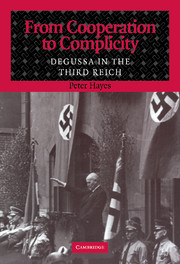Book contents
- Frontmatter
- Contents
- List of Illustrations
- List of Abbreviations
- Preface and Acknowledgments
- 1 Introduction and Overview
- 2 The Company, the Party, and the Regime
- 3 Aryanization
- 4 Autarky and Armament
- 5 Precious Metals for the Reich
- 6 War Production and Spoliation
- 7 Forced Labor
- 8 Degesch and Zyklon B
- 9 War's End and Aftermath
- Appendices
- Index
1 - Introduction and Overview
Published online by Cambridge University Press: 03 November 2009
- Frontmatter
- Contents
- List of Illustrations
- List of Abbreviations
- Preface and Acknowledgments
- 1 Introduction and Overview
- 2 The Company, the Party, and the Regime
- 3 Aryanization
- 4 Autarky and Armament
- 5 Precious Metals for the Reich
- 6 War Production and Spoliation
- 7 Forced Labor
- 8 Degesch and Zyklon B
- 9 War's End and Aftermath
- Appendices
- Index
Summary
Contradictory as it sounds, in the era of the world wars, Degussa was a rather little big business. Only its lengthy formal name was imposing: the German Gold and Silver Separation Institute, Inc., formerly Roessler (AG Deutsche Gold- und Silber- Scheideanstalt vormals Roessler – it did not begin going by the acronym Degussa until 1943, as a time-saving measure for typists, and did not adopt the abbreviated name officially until 1980). None of even the firm's largest productive installations – those in and around the headquarters city of Frankfurt, at Rheinfelden by the Swiss border, and at Grünau and, after 1933, at Oranienburg, both near Berlin – remotely approached the size of the main works of such industrial giants as IG Farben, United Steelworks, Krupp, and Siemens. Indeed, Degussa's highest total labor force prior to 1945 (approximately 30,000 people, including those employed at majority-owned subsidiaries) never exceeded that at several of these corporations' mammoth production sites. Neither was its stock capitalization especially impressive – at 23 million marks in 1927, it came to a fraction of that invested in any of these enterprises or in such other well-known firms as Mannesmann and AEG. By this measure, in fact, Degussa ranked only sixty-fourth out of the 100 largest German industrial entities in that year and tenth among the thirteen chemicals firms on the list.
While the firm improved somewhat upon this relative standing during the ensuing two decades, partly through expansion and partly because of the blows events dealt to competitors, Degussa's visibility on the German industrial landscape hardly increased.
- Type
- Chapter
- Information
- From Cooperation to ComplicityDegussa in the Third Reich, pp. 1 - 19Publisher: Cambridge University PressPrint publication year: 2004

